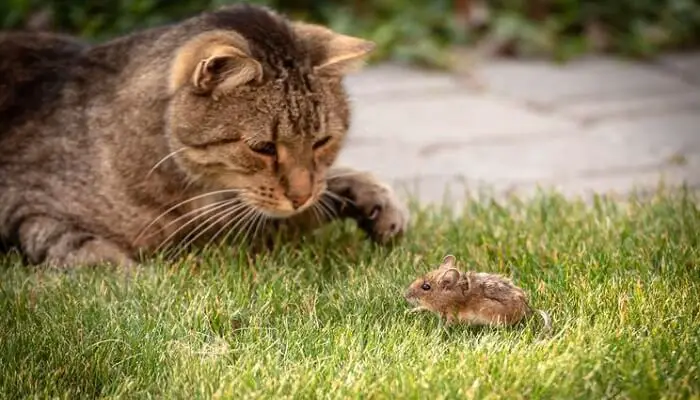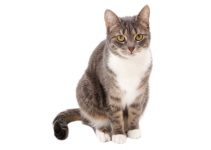Most of the time, cats will eat the entire mouse and will leave nothing behind. But, there are instances when they get to be picky. In these times, there will be two parts that they will most likely discard. These are the stomach and the tail.
Now, you may ask: Why would a cat not eat the tail and the stomach of a mouse?
Further, when will they discard these parts? And when do they get to eat everything entirely?
Let’s find out about it.
Contents
The Stomach
The reason why cats may discard the stomach is because of its awful taste.
Compared to the rest of the parts a mouse, the stomach by far has the awful taste.
The stomach is the part that is full of acid, which is why a won’t eat it.
While a rodent’s stomach isn’t as acidic as our stomach, it is still extremely acidic.
The pH of a mouse and rat stomach ranges from 3 to 3.2 if fed and 3.9 to 4.0 if not.
For us, acidic foods often have a sour taste. For this reason, a cat tasting the stomach may stop eating.
Further, the stomach is where the intestines lie.
While they are edible for cats, they are usually one of the most avoided parts due to bad taste.
Lastly, cats don’t like kidneys for some reason. Thus, with this organ located on the stomach, they would pass for it.
The Tail
The tail of a mouse may be edible for cats, but they seem like spikes that are usually very long.
Further, the tail can be pretty hard and chewy for any cat. Thus, cats will pass on this if they are in the mood for being picky.
When do cats become picky?
Cats can indeed become picky eaters. When they do, they will discard parts of the mice they caught.
Cats primarily become picky when they are still full and have just eaten or fed.
When it is currently well-fed, then it isn’t necessarily hungry. If ever it catches a mouse, it will get only the tastiest and the most accessible parts. Thus, it won’t pay attention to the rear part of the mouse.
If your cat is hungry and hasn’t eaten for a while, then it will eat everything. Most likely, your cat will devour the entire mouse from head to tail and leave nothing behind.
Remember: It doesn’t mean that when your cat is picky, it will stop chasing mice. A cat’s hunting nature doesn’t stop when it’s full.
Thus, even though you are always feeding your cat, it will still chase a mouse when it sees one.
What parts of a mouse do cats eat?
If it comes to the part that cats favor most, the answer would be the head.
For cats, the head is the best part, and it will come first in their list to eat.
The reason cats prefer heads the most is that it has the eyes that entice their hunting desire.
Thus, even if your cat is full and fed, it won’t resist a mouse’s head.
The rest of the body comes next.
Still, nothing beats the head.
Cats can eat rats as a whole, the same as anything they can catch and kill.
The bigger ones would most likely tear the fur as it thickens depending on the type.
Cats of all kinds are excellent hunters, especially once they get to learn how to do it.
They have excellent hearing, eyesight, whiskers, fangs, and protractible claws. Thus, they are famous for being one of the best predators in the world.
With rats loitering around defenseless, they hardly won’t get to survive and eat as a whole.
Related articles:
What about the bones? Do cats eat mice bones?
Cats that swallows an entire mouse gets to eat up the bones as well.
Wild cats live on their own. Thus, they chase and kill small prey such as mice and rats, along with all types of rodents. They can also hunt squirrels, rabbits, reptiles, amphibians, birds, insects, and small fishes.
Having all these small animals on their list makes it easier for them to include the bones.
A cat’s fangs can crush small bones of small animals. Thus, they won’t have to worry and chew to their fill.
Further, it is already a proven fact that bones can have an excellent effect on cats.
Eating pieces of meat with small bones exercises and strengthens their teeth.
Thus, the small bones of mice won’t be a problem for them. Besides, it will be quite a hassle if they would throw up the tiny bones.
Now, where do cats find mice?
Mice as prey: Where do cats find mice?
Mice are by nature prey animals, making them easy targets for predators around them.
They are easy prey since they never tend to fight back, especially to bigger predators than them.
It may be correct to say that mice are quick and tend to hide almost every time.
Even so, they need to come out eventually, seeking food.
Despite being fast, cats that chase them are excellent hunters. While they are quick, the cats can be more rapid.
Cats and mice usually get to have their play in houses and buildings.
They can also be doing so in farms and fields, but this scene is only for farm cats and farm rats.
Cats also loiter on streets, where rats are always present.
You May Also Read – Why do cats eat their babies?
Do all kinds of cats eat mice?
While every kind of cat tends to hunt mice, not all of them can and will eat one.
Domesticated cats come from a long line of predators that had to hunt to survive.
The natural prey of cats included birds, reptiles, and small rodents, to which mice and rats belong.
Thus, despite being a domestic or wild, every cat tends to pounce in every sighting of a mouse.
Even so, not all cats can eat their hunting game.
It is in this skill that the difference comes between house cats and feral cats.
Feral Cats
Feral, or commonly known as wild cats, live independently.
With no humans to feed them, they survive on their own.
They either scavenge through trash, steal leftovers, or hunt down mice and other animals.
Feral cats become skilled hunters out of their need to survive.
Thus, they will undoubtedly eat an entire mouse if they caught one.
House Cats
House cats are less likely to kill mice compared to feral cats.
They don’t need to hunt or do anything to survive, as their owners serve the food for them.
While it is possible to train kittens to hunt, their killing instinct isn’t around anymore.
House cats still have the hunting instincts, as they would immediately react if they see a mouse.
Even so, these cats will most likely leave it hanging around if it successfully killed the mouse.
If not all cats can eat a mouse, is there a specific breed of cat that is good for hunting mice?
Which breed of cat is the best mouser?
The cat breed is of lesser importance when it comes to mouse hunting. Even so, there are breeds that standout if the mouse hunting ability is on the question.
The following are the breeds known for being great mice hunters:
Siamese
This breed eventually forms the Burmese, Himalayan, and Ocicat breeds. Even so, the first kind is still known as a favorite mouser and ratter.
Maine Coon
This breed has been held high for being great mouse hunters since the ancient times.
Persian
Persian cats are famous for their high intelligence, which is above average. The females of this breed are the ones gifted in catching mice.
Turkish Angora
Graceful, sure-footed breed, Turkish Angora Cats possesses both intelligence and wit in streets. This trait gives them skills enough to catch mice.
Chartreux
The Chartreux cats are a muscular breed, and they are born hunters. Thus, they are likely to give all they got when it comes to hunting their prey.
Burmese
Burmese cats think with their stomach. They can survive anywhere, in various environments. To return their favor, you can count on their mouse-hunting abilities anytime.
American Shorthair
These cats are famous for helping visitors and travelers keep the mice out of the food stores.
Manx
This breed is a popular one for those who live in the sea. A Manx is a skilled hunter, both in ships and in drylands. In the land, they are favored by farmers, as they keep rodents and pests away from their crops.
Siberian
This breed of cat is one of the big cats. Siberian cats can weigh up to 20 pounds. Even so, they will surprise you with their grace and agility despite being humongous.
Japanese Bobtail
These cats are famous for being hunting cats. They are famous for helping silk factories lessen the mouse population in their area.
Summary
- While cats can eat an entire mouse, they can also discard other parts from time to time. These parts are the tail and the stomach.
- Cats discard a mouse’s stomach because of its awful taste. Cats leave a mouse’s tail because it’s spiky, hard, and chewy.
- Cats become picky when they are full, and they eat everything when they are hungry.
- The most favored mouse part for cats is the head. Cats will eat the head immediately, even if they aren’t hungry.
- Not all cats eat a mouse. Feral cats are more likely to eat mice while house cats will only play with them or hunt them down.
- All cats can hunt mice, but certain breeds stand out in this skill.
Did you enjoy learning this about Cats? We hope you learned something new.



